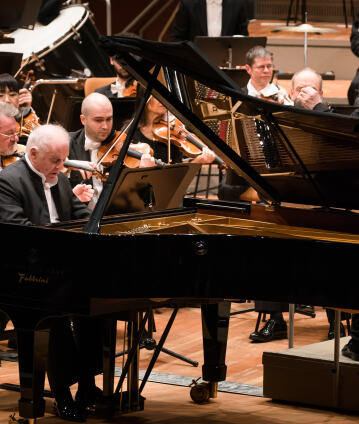Simon Rattle and Daniel Barenboim with Bartók’s Piano Concerto No. 1

In 1964, Daniel Barenboim made his acclaimed debut with the Berliner Philharmoniker playing Bartók’s Piano Concerto No. 1. Now, with Simon Rattle as conductor, he again devotes himself to this fascinating piece in which the piano is featured as an unrelenting percussion instrument. The other works on the programme are also marked by energetic urgency: Janáček’s Sinfonietta with its striking fanfares and Dvořák’s Slavonic Dances.
The long artistic friendship between Daniel Barenboim and the Berliner Philharmoniker began with Bartók’s First Piano Concerto. Wolfgang Stresemann, general manager of the orchestra at that time, had the young pianist in mind for a Philharmoniker concert programme under the direction of Pierre Boulez in June 1964: “If you want to play there, you’ll first have to learn Béla Bartók’s First Piano Concerto,” he said. Barenboim got the music and immediately fell in love with what was then a very rarely performed piece. Although Bartók based his composition on the classic three-part concerto form, the function of the piano is completely different to anything that had come before: He used the piano primarily as a percussion instrument that gives an energetic, vibrant and at the same time dance-like character to the inexorable, onward-driving momentum of the work. And at his debut, Barenboim succeeded in conveying just that. As one review described, “He played with virtuosity, intelligence, and in the slow movement in particular, he brings out Bartók’s sublimation of the rhythmical”. As a conductor, Barenboim has performed the concerto several times with the Philharmoniker in recent years, and now he is also to be heard as its soloist for the first time since 1964.
The use of folk music as a source of inspiration links Béla Bartók with the two other composers of this programme, Antonín Dvořák and Leoš Janáček. Dvořák made his international breakthrough with his lively Slavonic Dances op. 46. Only a few years later, the Czech master went one better with a sequel. Unlike the first series, the second, Dvořák’s opus 72, is dominated by dance forms from neighbouring Slavic countries with more melancholy, contemplative and introverted individual numbers. While Sir Simon Rattle and the Berliner Philharmoniker often like to perform individual dances, the presentation of the entire opus 72 is more of a rarity.
Folk music-based dance rhythms also characterise the Sinfonietta by Dvořák’s compatriot Leoš Janáček. But the piece, whose famous opening fanfare was composed in 1926 for a celebration of the “Sokol” gymnastic association and was then expanded by the composer to a five-movement orchestral work, is more than a musical exploration of national dances; it is rather a patriotic avowal to the then fledgling Czech Republic and a tribute to Janáček’s home town of Brno – powerful, evocative and triumphant.
© 2018 Berlin Phil Media GmbH
Artists
Our recommendations
- Simon Rattle and Daniel Barenboim play Brahms
- A Beethoven evening with Daniel Barenboim, Itzhak Perlman and Yo-Yo Ma
- Chopin’s Piano Concertos Nos. 1 & 2 with Daniel Barenboim und Asher Fisch
- 1994 Europakonzert from Meiningen with Claudio Abbado and Daniel Barenboim
- Claudio Abbado and Daniel Barenboim with Beethoven and Brahms
- Kirill Petrenko and Daniel Barenboim